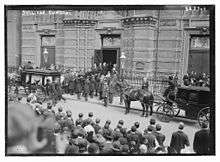James Edward Sullivan


James Edward Sullivan (November 18, 1862 – September 16, 1914) was an American sports official of Irish descent. He was one of the founders of the Amateur Athletic Union (AAU) in 1888, serving as its secretary from 1889 until 1906 when he was elected as President of the Amateur Athletic Union from 1906 to 1909. He declined a fourth term and was re-elected to his former position as secretary-treasurer until his sudden death which followed an emergency operation. Sullivan also served as the chairman of the Greater New York Irish Athletic Association in 1903 and on the New York City Board of Education from 1908 to 1912.[1]
Biography
He was born on November 18, 1862 in New York City.
His business career began in 1878 at Frank Leslie's publications.[1] In 1880 he started a paper, The Athletics News. His career continued in sports publishing, and sporting goods businesses. His athletics on the track had started in 1877 as a member of the Pastime Athletic Club. In 1888 and 1889 he won the all round championship of the club.
He also was one of the most influential people in the early Olympic movement, although his relationship with IOC president Pierre de Coubertin was tense. Sullivan was also an organizer of the Outdoor Recreation League and served as its second president.
1904 St. Louis Olympic Games
Sullivan was a chief organizer of the 1904 Summer Olympics. He decided to allow only two water stations on the 24.85 mile course of the marathon even though it was conducted in 32 °C (90 °F) heat over unpaved roads choked with dust. His ostensible reason was to conduct research on "purposeful dehydration," even though dehydration is potentially fatal. The marathon ended with the worst ratio of entrants to finishers (14 of 32) and by far the slowest winning time, 3:28:45, almost 30 minutes slower than the second fastest winning time.[2]
1908 London Olympic Games
During the 1908 London Olympic Games, Sullivan was Secretary of the United States Olympic Committee. He lodged a stream of protests, averaging almost one per day, over two weeks. It seems that Sullivan may have been trying to consolidate his position in the sporting hierarchy at home, and he felt that he must be seen to be fighting for the rights of the American team. His complaints went down well in the sensationalist press but in the more respected and responsible journals there was a quite different view of Sullivan’s behaviour.[3] On his return to the U.S. Sullivan said, "The victory of the American team at the Olympic Games was undoubtedly the greatest in the history of Amateur sport in the world, when it is taken into consideration the handicaps the members were subjected to. I do not wish to criticise British sportsmen generally, for there are many fair minded people among them but I want to make it as strong as possible that the attitude of Messrs. Davidson, Andrews, Fischer, and Dr. Bulger, the English Officials of the games, was not only outrageous to Americans, but contrary to their own rules, and if these men continue to dictate affairs, England will become athletically degenerate."[4]
1912 Stockholm Olympic Games
The 1912 Summer Olympics were opened to female divers and swimmers but he refused to allow American women, including swimmer Ida Schnall, to participate.[5]
In 1911 he was injured in a train wreck in Fort Wayne, Indiana.[1] He died on September 16, 1914 at Mount Sinai Hospital, New York after an operation on his intestines.[1] For the funeral on September 19, 1914, his body was conveyed from his home, 540 West 114th Street, to St. Aloysius Gonzaga's Church, at 132d Street and Seventh Avenue, where a requiem Mass was held.[6]
Legacy
In 1930, the AAU established the James E. Sullivan Award in his honour. It is awarded annually to the best amateur athlete in the US. In 1977, he was inducted into the National Track & Field Hall of Fame.[7]
Publications
- The Olympic games, Athens (1906)
- The Olympic games, Stockholm (1912)
References
- 1 2 3 4 "J.E. Sullivan Dies After an Operation. America's. Foremost Leader in Athletics and Recreation Work III Few Days. Did Much to Revive Classic Olympic Games and Was Strong. Factor In Public School Athletics". New York Times. September 17, 1914. Retrieved 2009-11-23.
- ↑ http://www.smithsonianmag.com/history/the-1904-olympic-marathon-may-have-been-the-strangest-ever-14910747/?no-ist
- ↑ Bill Mallon and Ian Buchanan 1908 Olympic Games: Results for All Competitors in All Events, With Commentary pub. McFarland 2008
- ↑ New York Times 8 August 1908
- ↑ Colette Dowling. The frailty myth: women approaching physical equality.
Ida Schnall, wanted to enter, but Sullivan put the kibosh on it. It wasn't until after he died, in 1914, that the gates to the competition began to open ...
- ↑ "J. E. Sullivan's Funeral. 60,000 Schoolboys Will Line Route of the Procession". New York Times. September 18, 1914. Retrieved 2011-09-23.
Between fifty and sixty thousand boys, members of the Public Schools Athletic League, an organization originated and fostered by the late James E. Sullivan, will line the route to be taken by the funeral procession when the athletic leader's body is conveyed from his home, 540 West 114th Street, tomorrow morning to the Catholic Church of St. Aloyslus, 132d Street and Seventh Avenue, where a solemn high mass of requiem will be celebrated. ...
- ↑ "James Sullivan". usatf.org. USA Track & Field, Inc. Retrieved 2009-04-01.